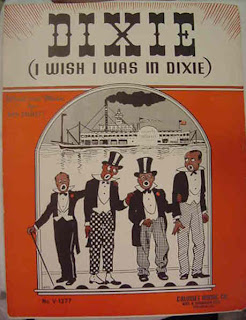Look Away
 I’d be remiss in letting the day pass without noting that April 4 is not only the 40th anniversary of Martin Luther King’s assassination but also the 149th anniversary of the first known performance of “Dixie” (or “Dixie’s Land”) by Bryant’s Minstrels in New York City. The song was a hit in New York in 1859, but it was its appearance a year later in New Orleans that helped convert this noxious little ode into the nearest thing to a national anthem the Confederacy would ever enjoy. Though we obviously associate the tune with the same streams of racist nostalgia that reinvigorated the symbols of the confederacy during the civil rights era, we should also remember that minstrelsy provided an immense cultural resource for Northern, working class whites throughout the middle decades of the 19th century.
I’d be remiss in letting the day pass without noting that April 4 is not only the 40th anniversary of Martin Luther King’s assassination but also the 149th anniversary of the first known performance of “Dixie” (or “Dixie’s Land”) by Bryant’s Minstrels in New York City. The song was a hit in New York in 1859, but it was its appearance a year later in New Orleans that helped convert this noxious little ode into the nearest thing to a national anthem the Confederacy would ever enjoy. Though we obviously associate the tune with the same streams of racist nostalgia that reinvigorated the symbols of the confederacy during the civil rights era, we should also remember that minstrelsy provided an immense cultural resource for Northern, working class whites throughout the middle decades of the 19th century.
As historians like David Roediger and Alexander Saxton have argued, minstrelsy — which in its early years involved northern white performers, smeared with burnt cork or grease, presenting what they usually claimed to be the “authentic culture” of plantation slaves — lay at the center of a “democratic” worker’s culture that was founded on racial chauvinism and pre-industrial nostalgia. Minstrel shows projected onto enslaved blacks a mythic identity that white workers had supposedly lost in the transition to industrialism; slaves were portrayed as boundlessly joyful, guileless and yet erotic and unhindered by the demands of respectable behavior. Of course, they were also portrayed as illiterate, present-minded rubes, which were precisely the same characteristics that appeared to define African Americans as unsuited for liberty or citizenship. The minstrel show’s actors and audiences understood that they were sharing a mere performance, but in their insistence that the (white) performance was based on genuine black attributes that couldn’t — unlike burnt cork — be washed away, they effectively argued that whites and blacks didn’t (and shouldn’t) share the same time and space. Songs like “Dixie,” in other words, made white people feel good about the fact that they were white. They even contributed to a shared sense of “whiteness” itself, as the differences between European ethnic groups diminished by comparison to the gross stereotypes of the plantation darky.
The scholarship on minstrelsy is vast and complex, of course, and the genre became even more vexed when black performers like Bert Williams rose to prominence at the turn of the century. The dozens of different versions of “Dixie” that were performed over the years were no less complicated, especially since Confederate sympathizers often tried to convert the tune into a more respectable “patriotic” anthem rather than an artifact of “low” urban (and Northern culture). It’s worth pointing out that neo-Confederate organizations like the United Daughters of the Confederacy spent years trying to standardize the song in the late 19th and early 20th centuries, mostly by stripping the lyrics of bawdy jokes and eliminating the caricatures of black dialect that defined the music of the minstrel show. Still, it’s that version of “Dixie” that most Americans are familiar with, and it’s that version — the deliberately nationalist one that arose during the formative years of the Jim Crow system — that racist throwbacks like Clint Johnson defend against the “genocidal” armies of political correctness.


